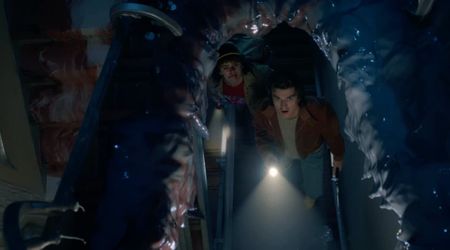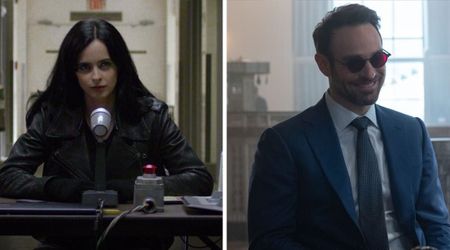Guilty until proven innocent: 'The Last Defense' explores the story behind Darlie Routier's death penalty conviction

'The Last Defense' premiered on ABC Television Network this past Tuesday with the investigative docu-series exploring the controversial death penalty cases of two of the country's most infamous criminals: Darlie Routier and Julius Jones. Executive produced by Viola Davis, Julius Tennon, and Andrew Wang, the series will 'explore and expose flaws in America's justice system' by delving into the cases and personal lives of the two inmates who, to this day, maintain their innocence.
Davis' rich voice introduces us to the cases explored in the show, stating that close to 3,000 prisoners are waiting on death row in the country. Out of these 3,000, five are exonerated on the basis of new DNA evidence and other developments in investigative techniques. So, the question remains, how many more are wrongfully executed for crimes they did not commit? Is there a possibility that Routier and Jones are innocent? Episode one of the docu-series looks at the Routier case.
The murders:
June 6, 1996 - 2:31 am: A near-delirious 26-year-old Routier calls 911 from her home in 5801 Eagle Driver, Rowlett, Texas, and tells the operators that an intruder broke into her home, stabbed her and her two children — 6-year-old Devon and 5-year-old Damon — and made his escape. Despite the early hours of the morning, police were at the scene within three minutes of the call and, after a cursory search of the house and the grounds, they did not manage to locate an intruder.
She was sleeping in the den with the two boys while her husband, Darin Routier, was reportedly sleeping upstairs with the couple's seven-month-old son, Drake.
Devon was pronounced dead on the spot, with Routier and Damon sustaining significant wounds. The mother had been cut in the neck, shoulder, and arms while Damon had been stabbed through the chest. They were rushed to the Baylor Hospital, with Damon declared dead in the ambulance and Routier rushed into surgery. She was discharged from the hospital just two days later.
Lt David Nabors has worked for the Rowlett Police Department for over 30 years and was the head of the department's Criminal Investigations Divisions at the time. As such, he was put in charge of the murder case and was tasked with apprehending the assailant who Routier only described as 'a white man wearing dark clothes and a baseball cap.'
Talking about the night, Nabors said: "Initially, when I got there, Darlie met the police officer with a towel around her neck putting pressure on her neck. When he walked to the back, he saw the 6-year-old laying there face up, already deceased."
The hunt lasted a total of 13 days, at the end of which, the department came to the conclusion that the murders were an inside job. Darin was ruled out as a possible suspect and Routier was arrested in connection with the deaths of her two children, much to the shock of her husband who proclaimed that she was innocent.
Because the horrific murders had taken place in a small, sleepy town such as Rowlett where everyone was close and Routier was well-known, support poured in immediately for the incarcerated mother. It was just not possible that such a caring, well-meaning woman could have committed such a heinous crime. Or was it?
Her version of events:
According to Routier's version of events, she had been sleeping on the couch when she felt one of her sons tersely push up against her. She woke up to see the intruder standing over her with a butcher's knife from the kitchen and he attacked her and her children. He then made his way through the kitchen — breaking a glass in the process — and into the utility room, before heading into the garage and making his escape through an open window.
Routier, in the voluntary statement, said she initially attempted to run after him and that she found the murder weapon lying down in the room and stopped. She then decided that her children would not survive if not tended to and proceeded to call 911. In the years past, she has corroborated the story numerous times, though investigators claim that there is little credibility to it.
The case against Routier:
During her trial — which was being prosecuted by Assistant District Attorney Greg Davis, with Toby Shook and Sherri Wallace assisting — the first point of contention was the six-minute 911 call. Investigators say that instead of displaying concern for her wounded children, Routier told the operators she was worried about having touched the murder weapon and whether they would now be able to retrieve prints from them. She also mentions that her husband ran downstairs in response to her screams but fails to ask about her infant son.
Officers also testified that while the mother was screaming and upset, she did not seem to be in shock and was very alert to the happenings around her. One also said that when he instructed Routier to apply pressure to the stab wounds on Damon's back, she ignored him entirely.
There were also inconsistencies with her account of the events of the night, or so the prosecutors felt. While Routier said that he broke the glass on his way out, her blood was found underneath it, which could not have been possible if that were indeed the case. Furthermore, investigators did not find blood in the garage, and the window sills through which she said he had escaped still had layers of dust, indicating that they had not been disturbed.
Her claim that she had found the knife in the utility room did not seem to hold up either as there was no blood spatter to indicate that it had been dropped. A noticeable lack of blood on the couch where she said she was stabbed, apparent attempts to clean the countertop and sink before the police arrived were brought up against her in court as well.
The version of events where the assailant escaped from the garage by cutting his way through a fiber screen failed to stand up to scrutiny as well. During a sweep of the crime scene, the investigators confiscated all the kitchen knives and found that one had microscopic traces of the exact same fiber that had been used to slash the screen, indicating that she may have staged a fake escape.
However, it was possibly the 'expert' testimonies of crime scene consultant James Cron, her surgeon at Baylor Hospital, and blood spatter expert Tom Bevel that did the most damage. Cron, who had investigated hundreds of crime scenes at the point, testified that, according to his expertise, he felt that the crime scene had been staged.
Her surgeon stated that he felt her wounds were superficial and self-inflicted, and Bevel told the court that the cast-off blood found on the back of her blood-stained nightshirt indicated that she had raised the knife over her head as she withdrew it from each boy to stab again.
Because of the lack of motive, a confession, or witnesses, the prosecution worked tirelessly to portray Routier as a pampered, materialistic woman with substantial debt, plummeting credit ratings, and little money in the bank, who feared that her lavish lifestyle was about to come to an end. They pointed out to her extravagant spending and an entry in her personal diary in which she 'asked for forgiveness for what she was about to do,' though it was the Silly String video that arguably turned the tide in their favor for good.
June 14 was supposed to be Devon's seventh birthday and Routier said that plans to celebrate the day were already in place before the murder.
On the day, a prayer service was held at the boys' joint-grave site and was attended by family and friends who brought along with them gifts, balloons, and trinkets to adorn the grave. Her sister, Dana, had arranged the day's festivities and brought cans of 'Silly String' which she and her sister sprayed with great aplomb.
The scene was caught on camera by the local media, and the video was subsequently used in the trial and played in front of the jury countless times. The prosecutors pointed out how such joy and frivolity from a mother who had just lost her children in a double homicide eight days prior was unbecoming and questioned her mental state at the time.
They heavily edited the video to show only the portion where Routier and her sister were spraying silly string on the gravesite and cut out the bits where the mother was shown in a somber mood at the prayer service. Their intention was to make the jury believe that she was a remorseless, uncaring mother whose actions were that of a guilty person. They succeeded.
The case for Routier:
Routier was initially assigned court-appointed attorney Doug Parks to defend her and because Darin was informed that their chances of a not-guilty verdict significantly decreased with the appointment, they went out of their way to hire one of the best criminal defense lawyers in the state: Doug Mulder.
Mulder and the defense team worked to show that the prosecution had built its case on nothing more than circumstantial evidence. They cross-examined the prosecution's points of contention, arguing that the 911 call could be explained because Routier was traumatized and distracted by the chaos in the home at the time and that she could not be held accountable for what she said or did at the time. They had a psychiatrist even testify that she was a victim of 'traumatic amnesia.'
Explaining away how her blood could have gotten 'underneath' the broken glass, they said that it was entirely plausible the crime scene had been disturbed by the constant hustle and bustle of paramedics and investigators who were at the home during the initial few hours. A restaging of the crime also proved that it was possible to escape without disturbing the layers of dust that had gathered on the windows.
The prosecution's argument that the knife could not have been found in the utility room because of a lack of blood spatter was far-fetched as well. A pattern would have been left behind only if the knife had been caked entirely in blood, with the more realistic possibility being that the blood had dried up in the time investigators got to the scene. Mulder similarly argued that the microscopic fibers on the butter knife were a result of human error, a scenario that is not beyond imagination in such exact sciences.
A piece of evidence that the prosecution was unable to logically explain was a sock found 75 yards away in an alley at the rear of the Routier home. It was discovered by an officer who was conducting a search of the alley and, upon examination, was found to contain a bloodstain the size of an 'elongated nickel.' The blood belonged to Devon and Demon.
The defense said that if the prosecution's allegation that Darlie had staged the crime scene were true, then it was implausible that she had run down the alley, planted the sock and then returned to the home without a single trace of her blood in the area. In his opening statement, her attorney sarcastically quipped: "Somehow, this doting mother turned psychotic killer, went and dipped, just ever so slightly, an amount of her children’s blood in that sock and then ran 75 yards down the alleyway, and planted it, while her husband is upstairs asleep."
The aforementioned 'expert' testimonies were systematically taken apart one by one too. Cron was found to have come to his conclusion that the scene had been staged on nothing more than a hunch. He admitted that he had taken all of 20 minutes to decide that the murder was an inside job. Similarly, San Antonio chief medical examiner Vincent DiMaio testified that the wound to Routier's neck came within two millimeters of her carotid artery, which if breached, could have easily resulted in the mother bleeding out to death on the spot. He said the wounds were inconsistent with self-inflicted wounds he had come across in the past.
Mistakes were made:
On a similar note, Tom Bevel was later found to have significantly exaggerated and falsely testified in several of the cases he had been asked to provide an opinion on, including that of Routier's. Other experts in the field questioned his version of events and provided evidence which suggested that it was impossible for the specks of blood to get onto the back of her nightshirt unless the motions of stabbing were unrealistically aggrandized.
Bevel had also not written a report on his findings, which was ethically a big red flag, meaning it could not be revisited in the case of a retrial. When asked about this, Bevel confessed he had done so on the advice of the prosecutors. Unfortunately, none of this was brought up at the trial because Mulder had decided that he would not be needing these other experts' testimonies to refute the claims brought up the prosecution. It would prove to be a critical mistake.
Another crucial error of judgment came from Routier's first lawyer, Parks. Parks, rightly fearing that his client would not receive a fair trial in Dallas County due to the excessive media coverage, filed a motion to have it moved to Kerrville. This played right into the prosecution's hands because the town was located in one of the state's most conservative counties with a very high conviction rate. When Mulder succeeded Parks, he immediately filed a motion with the court to have the trial moved back to Dallas County, but Judge Tolle struck down the motion.
Davis' intention was clear-cut from the very beginning. During the jury selection, he had proclaimed: "That she will be sentenced to die, and at some day in the future, she will be executed. That is our goal in this case."
He was granted his wish. Upon the trial's conclusion, the judge asked how many of the jurors felt that Routier deserved the death penalty; all 11 raised their hands.
The case of Susan Smith:
There were suggestions that overzealous and biased coverage by the media played its role in Routier's conviction and these were not too far-fetched. In the build-up to her trial, parallels were constantly drawn between Routier and another mother who had, as it turns out, falsely claimed that she was not responsible for the deaths of her children: Susan Smith.
On October 25, 1994, Smith, a resident of South Carolina, reported to the police that her vehicle had been carjacked by a black man who drove away with her sons still inside. For the next nine days, she made dramatic pleas on national television for their rescue and return. But on November 3, she confessed to letting the car roll into nearby John D Long Lake with the children inside, much to the anger of an entire nation.
The case was still fresh in the minds of jurors and residents of the county, who felt that Routier's case was just the Texas version of Smith's case. However, the parallels ended there. Smith was found to have grown up in an unstable home, attempted suicide as a 13-year-old and was molested when she was a teenager. She was also suffering from mental health issues and was diagnosed with dependent personality disorder and major depression. In contrast, Routier had no underlying issues whatsoever.
Present day:
Routier was convicted and sentenced to death by lethal injection for the murder of five-year-old Damon on February 4, 1997. Now, more than two decades later, she still remains in prison awaiting justice and is currently one of just six women on death row in the state of Texas. To this day, she insists on her innocence.
There is still hope for her case. In 2002, one of the jurors, Charles Samford, in an affidavit tendered to Routier's appeal attorneys, stated, "The videotape was one of the main reasons I voted to convict Mrs Routier of murder because I didn’t know what to make of her behavior."
He also said that, after the trial, they were shown a different video from Devon's birthday party, writing: "Had we been shown this other tape so that we had been able to see the whole picture of what happened that day, I believe I would not have voted to convict Mrs Routier."
In 2008, she was granted the right to new DNA tests and her appeals were remanded to the state level for improved DNA testing. Then, in 2014, Chief Judge of the Western District Fred Biery granted a request from prosecution and defense for her case for further DNA tests vital to the defense to be performed on a bloody fingerprint found in the house, a bloody sock and her nightshirt. There is still a chance, no matter how small, that she may escape the death row.










